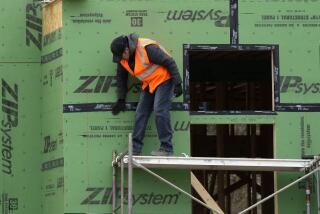Joblessness Under 6% in Factory Surge : 55,000 New Jobs and Return to School Improve Figure
- Share via
WASHINGTON — Unemployment in September fell through the 6% barrier for the first time this decade as the economy created 132,000 jobs, more than 40% of them in the rebounding manufacturing sector, the government said today.
Last month’s 5.9% rate--a 0.1 percentage point drop from the rate of July and August--came despite a drop of 309,000 in the number of working Americans to 112.7 million.
But the ranks of the unemployed declined at the same time by 132,000 to 7.1 million as the labor force shrank by 440,000 with the return to school of teen-agers who had held summer jobs.
Manufacturing employment rose by 55,000 in September, with large gains in the steel and machinery industries. Since June, the economy has produced 165,000 factory jobs, raising the manufacturing employment level to its highest point since August, 1985.
Before September, the seasonally adjusted unemployment rate had not been below 6% since November, 1979, when it also stood at 5.9%, the Labor Department said.
(California’s unemployment rate remained below the national figure in September at 5.8%, but was up from 5.4% in August, the Labor Department said.)
Industrial Recovery Cited
The commissioner of labor statistics, Janet L. Norwood, said the industrial recovery has affected the relationship between the national jobless rates for men and women.
“During the recession of the early 1980s, the predominantly male factory work force was hard hit, and the employment rate for men shot upward, surpassing the rate for women,” she told the congressional Joint Economic Committee.
“Partly because of the growth in factory jobs over the last few months, the rate for adult men has fallen to 5% in September, while the rate for adult women, at 5.4%, has shown little improvement.”
The jobless rates for men and women had mirrored each other at nearly 6% in December and had fallen together to 5.5% in April.
Employment growth slowed on the service-producing side of the economy, which has accounted for virtually all the job growth of the 1980s.
Retail trade showed the only real strength, adding 70,000 jobs last month, while the finance, insurance and real estate industries, which have grown steadily since 1982, failed to post any increase.
Norwood said the flat performance of those sectors “probably reflects the joint effects of rising interest rates and construction activity slowdown.”
Construction Jobs Down
Construction employment, adjusted for seasonal variations, dropped by 35,000 last month and is down by 60,000 from the end of last year.
New payroll jobs, calculated at 132,000, would have totaled about 200,000 were it not for strikes by teachers and other school personnel with the beginning of the fall term.
Although the overall jobless rate has fallen 1.1 percentage points since September, 1986, teen-agers have not fared as well as adults.
“The jobless rate for teen-agers has been relatively sticky,” Norwood said. “There has been considerable anecdotal evidence of localized labor shortages and rising wages in some jobs traditionally held by young people. Even so, their unemployment rate, at 16.3% in September, has shown less relative improvement than the adult rates” this year.
Government figures, however, show a large improvement for black teen-agers, historically the population group with the largest jobless rate. Unemployment among black teen-agers dropped from 38.4% in September, 1986, to 29.7% last month.
More to Read
Inside the business of entertainment
The Wide Shot brings you news, analysis and insights on everything from streaming wars to production — and what it all means for the future.
You may occasionally receive promotional content from the Los Angeles Times.










